Holmes Institute HI6028 Taxation Law Individual Assignment
VerifiedAdded on 2022/11/26
|9
|2354
|291
Homework Assignment
AI Summary
This taxation assignment solution addresses several key aspects of Australian tax law. Part 1 examines the Capital Gains Tax (CGT) consequences of selling collectible assets like antique paintings, sculptures, and jewelry, analyzing cost bases, cost proceeds, and potential gains or losses under the Income Tax Assessment Act 1997. Part 2 delves into whether income from writing a book is assessable income derived from personal exertion and how copyright sales are treated. Part 3 explores the tax implications of loan repayments, determining whether such repayments constitute assessable income for the lender. The assignment provides detailed analysis of relevant sections of the ITAA, case law, and tax rulings to support its conclusions.

Running head: TAXATION
Taxation
Name of the Student
Name of the University
Author Note
Taxation
Name of the Student
Name of the University
Author Note
Paraphrase This Document
Need a fresh take? Get an instant paraphrase of this document with our AI Paraphraser
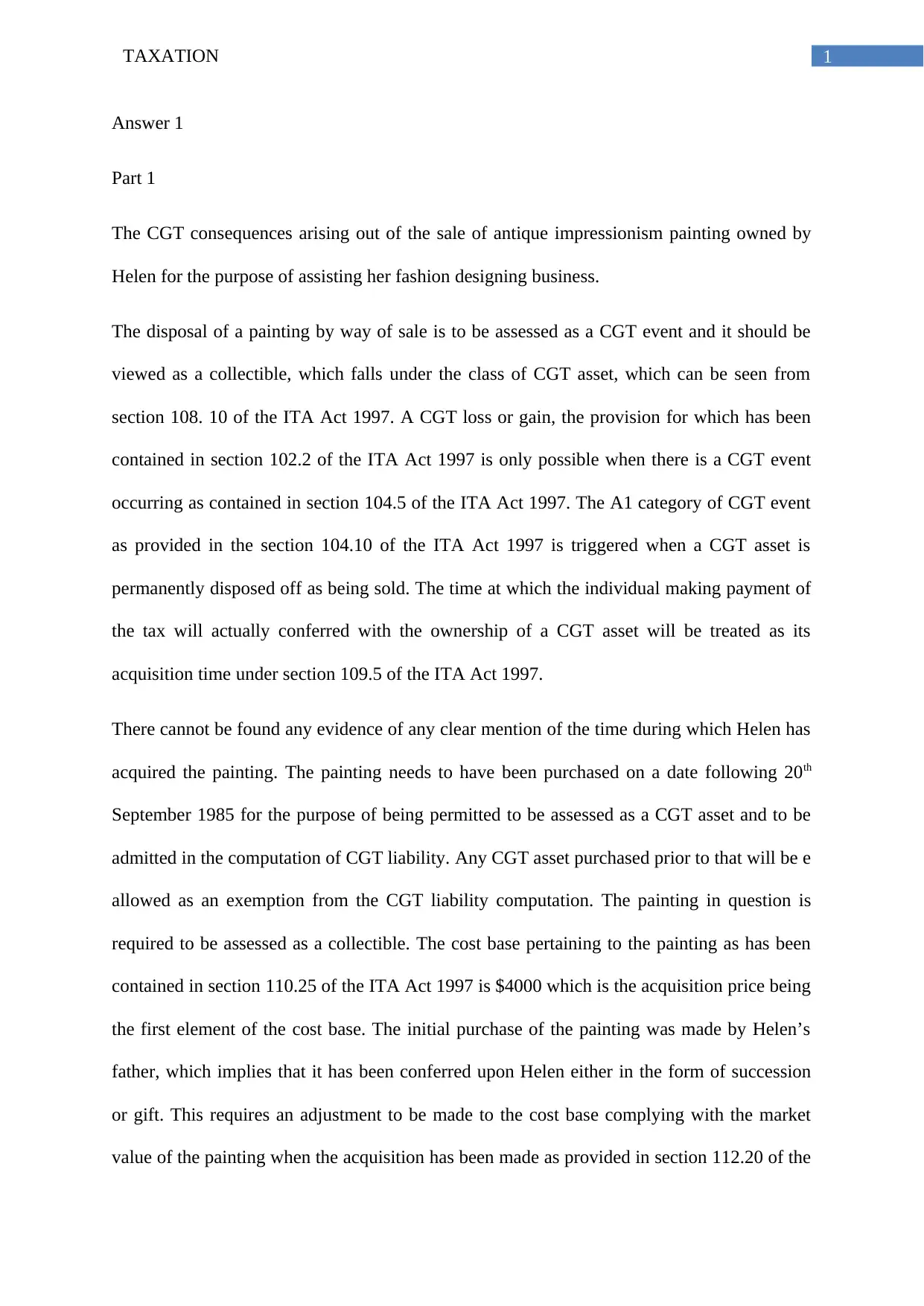
1TAXATION
Answer 1
Part 1
The CGT consequences arising out of the sale of antique impressionism painting owned by
Helen for the purpose of assisting her fashion designing business.
The disposal of a painting by way of sale is to be assessed as a CGT event and it should be
viewed as a collectible, which falls under the class of CGT asset, which can be seen from
section 108. 10 of the ITA Act 1997. A CGT loss or gain, the provision for which has been
contained in section 102.2 of the ITA Act 1997 is only possible when there is a CGT event
occurring as contained in section 104.5 of the ITA Act 1997. The A1 category of CGT event
as provided in the section 104.10 of the ITA Act 1997 is triggered when a CGT asset is
permanently disposed off as being sold. The time at which the individual making payment of
the tax will actually conferred with the ownership of a CGT asset will be treated as its
acquisition time under section 109.5 of the ITA Act 1997.
There cannot be found any evidence of any clear mention of the time during which Helen has
acquired the painting. The painting needs to have been purchased on a date following 20th
September 1985 for the purpose of being permitted to be assessed as a CGT asset and to be
admitted in the computation of CGT liability. Any CGT asset purchased prior to that will be e
allowed as an exemption from the CGT liability computation. The painting in question is
required to be assessed as a collectible. The cost base pertaining to the painting as has been
contained in section 110.25 of the ITA Act 1997 is $4000 which is the acquisition price being
the first element of the cost base. The initial purchase of the painting was made by Helen’s
father, which implies that it has been conferred upon Helen either in the form of succession
or gift. This requires an adjustment to be made to the cost base complying with the market
value of the painting when the acquisition has been made as provided in section 112.20 of the
Answer 1
Part 1
The CGT consequences arising out of the sale of antique impressionism painting owned by
Helen for the purpose of assisting her fashion designing business.
The disposal of a painting by way of sale is to be assessed as a CGT event and it should be
viewed as a collectible, which falls under the class of CGT asset, which can be seen from
section 108. 10 of the ITA Act 1997. A CGT loss or gain, the provision for which has been
contained in section 102.2 of the ITA Act 1997 is only possible when there is a CGT event
occurring as contained in section 104.5 of the ITA Act 1997. The A1 category of CGT event
as provided in the section 104.10 of the ITA Act 1997 is triggered when a CGT asset is
permanently disposed off as being sold. The time at which the individual making payment of
the tax will actually conferred with the ownership of a CGT asset will be treated as its
acquisition time under section 109.5 of the ITA Act 1997.
There cannot be found any evidence of any clear mention of the time during which Helen has
acquired the painting. The painting needs to have been purchased on a date following 20th
September 1985 for the purpose of being permitted to be assessed as a CGT asset and to be
admitted in the computation of CGT liability. Any CGT asset purchased prior to that will be e
allowed as an exemption from the CGT liability computation. The painting in question is
required to be assessed as a collectible. The cost base pertaining to the painting as has been
contained in section 110.25 of the ITA Act 1997 is $4000 which is the acquisition price being
the first element of the cost base. The initial purchase of the painting was made by Helen’s
father, which implies that it has been conferred upon Helen either in the form of succession
or gift. This requires an adjustment to be made to the cost base complying with the market
value of the painting when the acquisition has been made as provided in section 112.20 of the
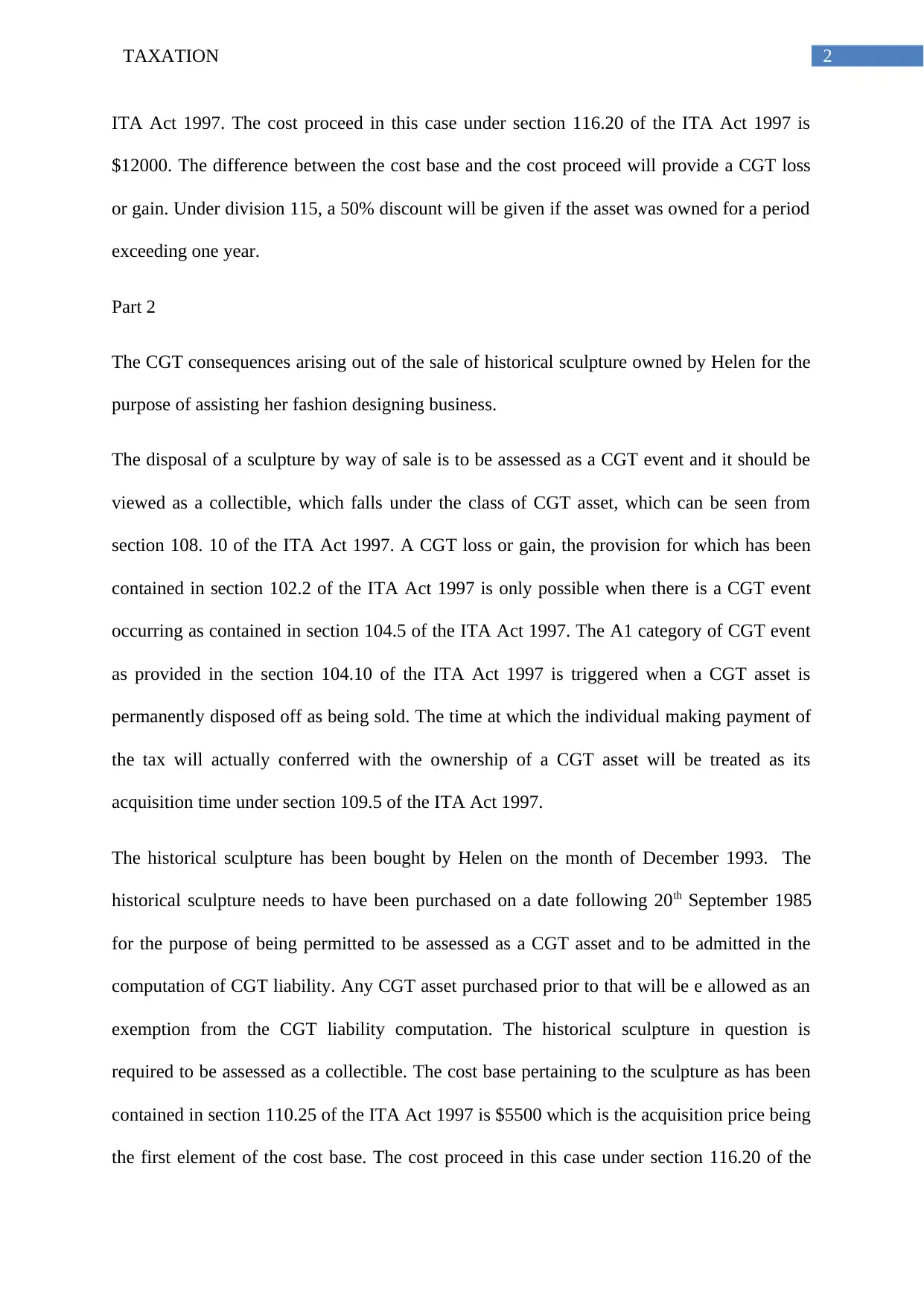
2TAXATION
ITA Act 1997. The cost proceed in this case under section 116.20 of the ITA Act 1997 is
$12000. The difference between the cost base and the cost proceed will provide a CGT loss
or gain. Under division 115, a 50% discount will be given if the asset was owned for a period
exceeding one year.
Part 2
The CGT consequences arising out of the sale of historical sculpture owned by Helen for the
purpose of assisting her fashion designing business.
The disposal of a sculpture by way of sale is to be assessed as a CGT event and it should be
viewed as a collectible, which falls under the class of CGT asset, which can be seen from
section 108. 10 of the ITA Act 1997. A CGT loss or gain, the provision for which has been
contained in section 102.2 of the ITA Act 1997 is only possible when there is a CGT event
occurring as contained in section 104.5 of the ITA Act 1997. The A1 category of CGT event
as provided in the section 104.10 of the ITA Act 1997 is triggered when a CGT asset is
permanently disposed off as being sold. The time at which the individual making payment of
the tax will actually conferred with the ownership of a CGT asset will be treated as its
acquisition time under section 109.5 of the ITA Act 1997.
The historical sculpture has been bought by Helen on the month of December 1993. The
historical sculpture needs to have been purchased on a date following 20th September 1985
for the purpose of being permitted to be assessed as a CGT asset and to be admitted in the
computation of CGT liability. Any CGT asset purchased prior to that will be e allowed as an
exemption from the CGT liability computation. The historical sculpture in question is
required to be assessed as a collectible. The cost base pertaining to the sculpture as has been
contained in section 110.25 of the ITA Act 1997 is $5500 which is the acquisition price being
the first element of the cost base. The cost proceed in this case under section 116.20 of the
ITA Act 1997. The cost proceed in this case under section 116.20 of the ITA Act 1997 is
$12000. The difference between the cost base and the cost proceed will provide a CGT loss
or gain. Under division 115, a 50% discount will be given if the asset was owned for a period
exceeding one year.
Part 2
The CGT consequences arising out of the sale of historical sculpture owned by Helen for the
purpose of assisting her fashion designing business.
The disposal of a sculpture by way of sale is to be assessed as a CGT event and it should be
viewed as a collectible, which falls under the class of CGT asset, which can be seen from
section 108. 10 of the ITA Act 1997. A CGT loss or gain, the provision for which has been
contained in section 102.2 of the ITA Act 1997 is only possible when there is a CGT event
occurring as contained in section 104.5 of the ITA Act 1997. The A1 category of CGT event
as provided in the section 104.10 of the ITA Act 1997 is triggered when a CGT asset is
permanently disposed off as being sold. The time at which the individual making payment of
the tax will actually conferred with the ownership of a CGT asset will be treated as its
acquisition time under section 109.5 of the ITA Act 1997.
The historical sculpture has been bought by Helen on the month of December 1993. The
historical sculpture needs to have been purchased on a date following 20th September 1985
for the purpose of being permitted to be assessed as a CGT asset and to be admitted in the
computation of CGT liability. Any CGT asset purchased prior to that will be e allowed as an
exemption from the CGT liability computation. The historical sculpture in question is
required to be assessed as a collectible. The cost base pertaining to the sculpture as has been
contained in section 110.25 of the ITA Act 1997 is $5500 which is the acquisition price being
the first element of the cost base. The cost proceed in this case under section 116.20 of the
⊘ This is a preview!⊘
Do you want full access?
Subscribe today to unlock all pages.

Trusted by 1+ million students worldwide
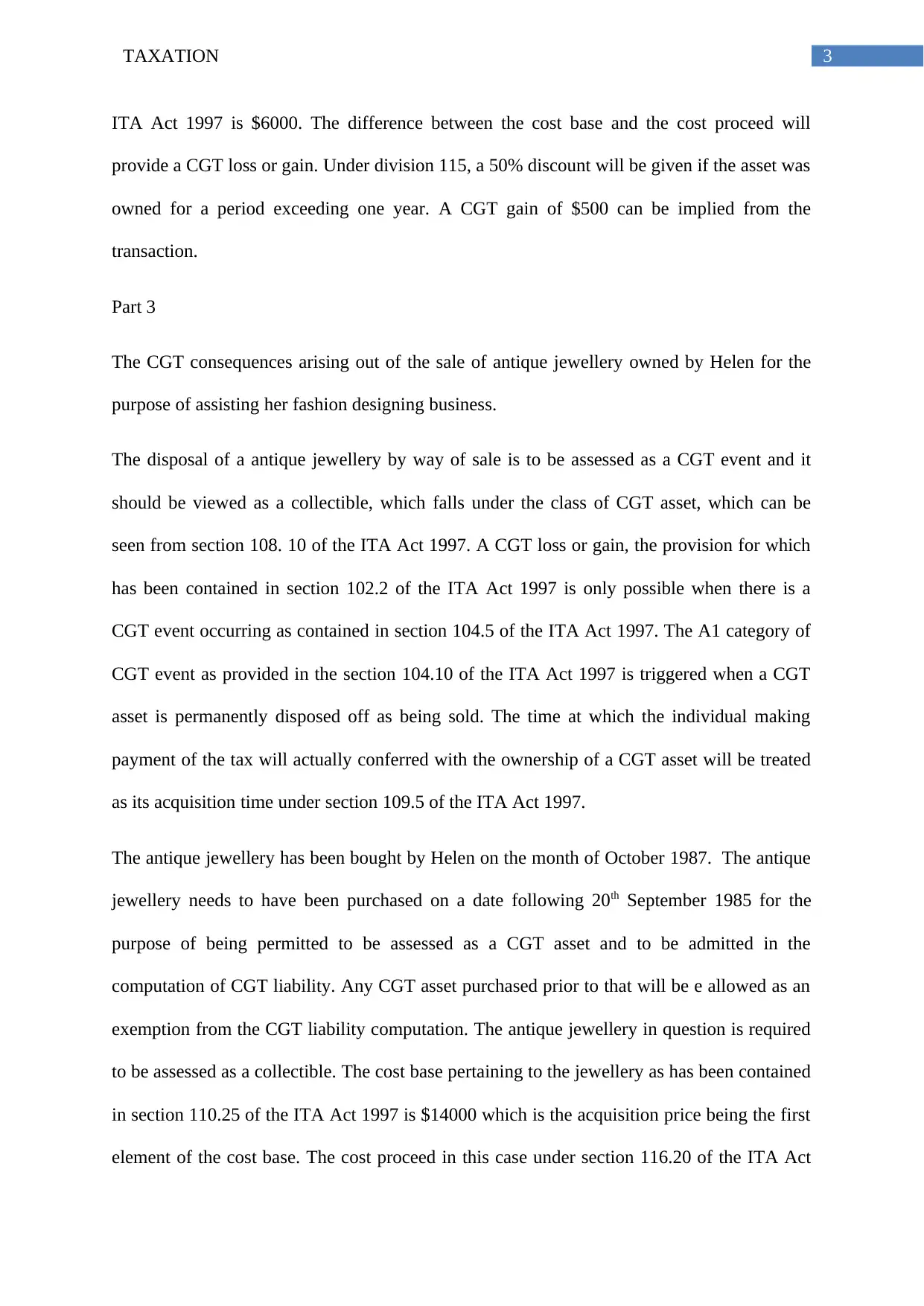
3TAXATION
ITA Act 1997 is $6000. The difference between the cost base and the cost proceed will
provide a CGT loss or gain. Under division 115, a 50% discount will be given if the asset was
owned for a period exceeding one year. A CGT gain of $500 can be implied from the
transaction.
Part 3
The CGT consequences arising out of the sale of antique jewellery owned by Helen for the
purpose of assisting her fashion designing business.
The disposal of a antique jewellery by way of sale is to be assessed as a CGT event and it
should be viewed as a collectible, which falls under the class of CGT asset, which can be
seen from section 108. 10 of the ITA Act 1997. A CGT loss or gain, the provision for which
has been contained in section 102.2 of the ITA Act 1997 is only possible when there is a
CGT event occurring as contained in section 104.5 of the ITA Act 1997. The A1 category of
CGT event as provided in the section 104.10 of the ITA Act 1997 is triggered when a CGT
asset is permanently disposed off as being sold. The time at which the individual making
payment of the tax will actually conferred with the ownership of a CGT asset will be treated
as its acquisition time under section 109.5 of the ITA Act 1997.
The antique jewellery has been bought by Helen on the month of October 1987. The antique
jewellery needs to have been purchased on a date following 20th September 1985 for the
purpose of being permitted to be assessed as a CGT asset and to be admitted in the
computation of CGT liability. Any CGT asset purchased prior to that will be e allowed as an
exemption from the CGT liability computation. The antique jewellery in question is required
to be assessed as a collectible. The cost base pertaining to the jewellery as has been contained
in section 110.25 of the ITA Act 1997 is $14000 which is the acquisition price being the first
element of the cost base. The cost proceed in this case under section 116.20 of the ITA Act
ITA Act 1997 is $6000. The difference between the cost base and the cost proceed will
provide a CGT loss or gain. Under division 115, a 50% discount will be given if the asset was
owned for a period exceeding one year. A CGT gain of $500 can be implied from the
transaction.
Part 3
The CGT consequences arising out of the sale of antique jewellery owned by Helen for the
purpose of assisting her fashion designing business.
The disposal of a antique jewellery by way of sale is to be assessed as a CGT event and it
should be viewed as a collectible, which falls under the class of CGT asset, which can be
seen from section 108. 10 of the ITA Act 1997. A CGT loss or gain, the provision for which
has been contained in section 102.2 of the ITA Act 1997 is only possible when there is a
CGT event occurring as contained in section 104.5 of the ITA Act 1997. The A1 category of
CGT event as provided in the section 104.10 of the ITA Act 1997 is triggered when a CGT
asset is permanently disposed off as being sold. The time at which the individual making
payment of the tax will actually conferred with the ownership of a CGT asset will be treated
as its acquisition time under section 109.5 of the ITA Act 1997.
The antique jewellery has been bought by Helen on the month of October 1987. The antique
jewellery needs to have been purchased on a date following 20th September 1985 for the
purpose of being permitted to be assessed as a CGT asset and to be admitted in the
computation of CGT liability. Any CGT asset purchased prior to that will be e allowed as an
exemption from the CGT liability computation. The antique jewellery in question is required
to be assessed as a collectible. The cost base pertaining to the jewellery as has been contained
in section 110.25 of the ITA Act 1997 is $14000 which is the acquisition price being the first
element of the cost base. The cost proceed in this case under section 116.20 of the ITA Act
Paraphrase This Document
Need a fresh take? Get an instant paraphrase of this document with our AI Paraphraser
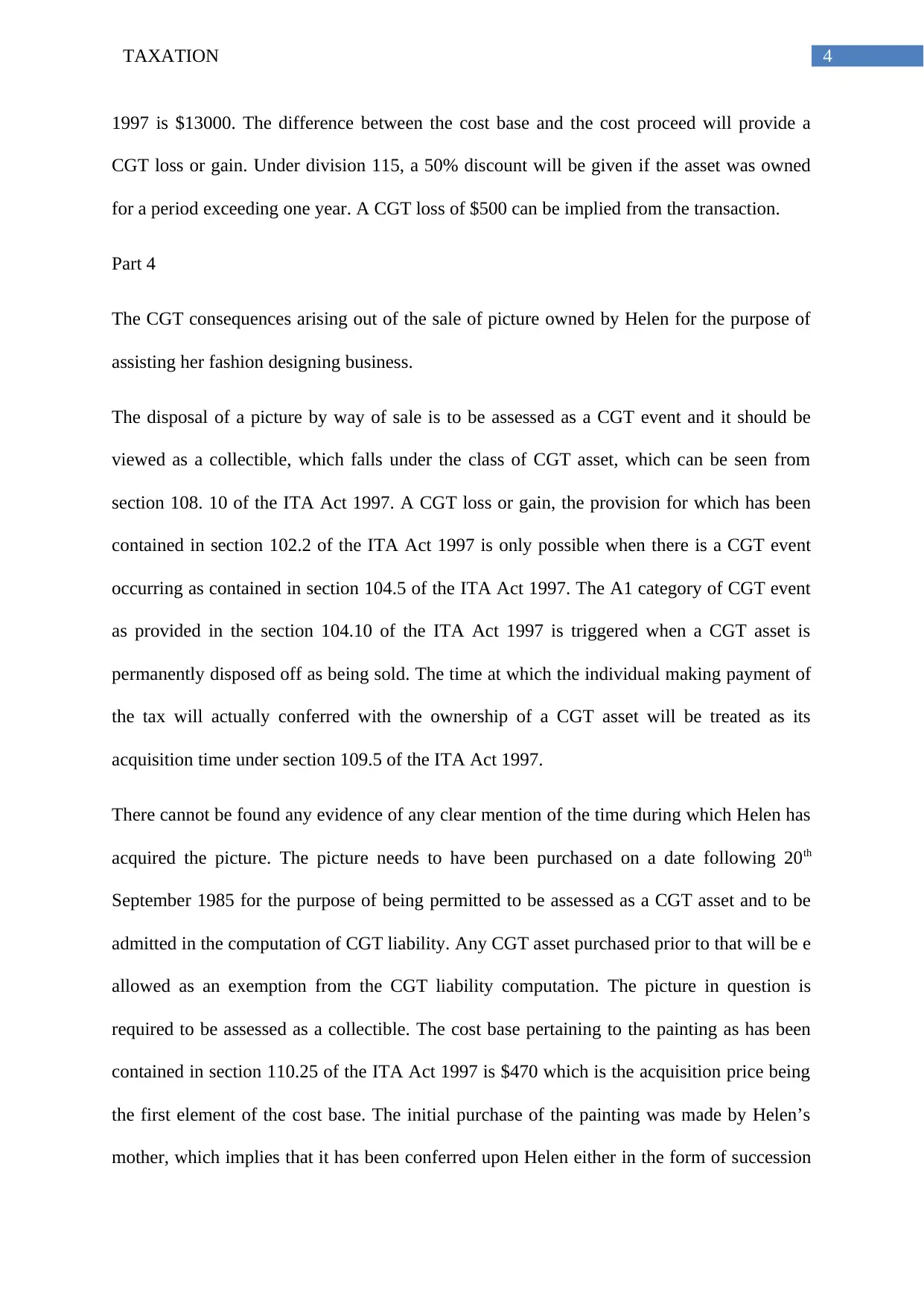
4TAXATION
1997 is $13000. The difference between the cost base and the cost proceed will provide a
CGT loss or gain. Under division 115, a 50% discount will be given if the asset was owned
for a period exceeding one year. A CGT loss of $500 can be implied from the transaction.
Part 4
The CGT consequences arising out of the sale of picture owned by Helen for the purpose of
assisting her fashion designing business.
The disposal of a picture by way of sale is to be assessed as a CGT event and it should be
viewed as a collectible, which falls under the class of CGT asset, which can be seen from
section 108. 10 of the ITA Act 1997. A CGT loss or gain, the provision for which has been
contained in section 102.2 of the ITA Act 1997 is only possible when there is a CGT event
occurring as contained in section 104.5 of the ITA Act 1997. The A1 category of CGT event
as provided in the section 104.10 of the ITA Act 1997 is triggered when a CGT asset is
permanently disposed off as being sold. The time at which the individual making payment of
the tax will actually conferred with the ownership of a CGT asset will be treated as its
acquisition time under section 109.5 of the ITA Act 1997.
There cannot be found any evidence of any clear mention of the time during which Helen has
acquired the picture. The picture needs to have been purchased on a date following 20th
September 1985 for the purpose of being permitted to be assessed as a CGT asset and to be
admitted in the computation of CGT liability. Any CGT asset purchased prior to that will be e
allowed as an exemption from the CGT liability computation. The picture in question is
required to be assessed as a collectible. The cost base pertaining to the painting as has been
contained in section 110.25 of the ITA Act 1997 is $470 which is the acquisition price being
the first element of the cost base. The initial purchase of the painting was made by Helen’s
mother, which implies that it has been conferred upon Helen either in the form of succession
1997 is $13000. The difference between the cost base and the cost proceed will provide a
CGT loss or gain. Under division 115, a 50% discount will be given if the asset was owned
for a period exceeding one year. A CGT loss of $500 can be implied from the transaction.
Part 4
The CGT consequences arising out of the sale of picture owned by Helen for the purpose of
assisting her fashion designing business.
The disposal of a picture by way of sale is to be assessed as a CGT event and it should be
viewed as a collectible, which falls under the class of CGT asset, which can be seen from
section 108. 10 of the ITA Act 1997. A CGT loss or gain, the provision for which has been
contained in section 102.2 of the ITA Act 1997 is only possible when there is a CGT event
occurring as contained in section 104.5 of the ITA Act 1997. The A1 category of CGT event
as provided in the section 104.10 of the ITA Act 1997 is triggered when a CGT asset is
permanently disposed off as being sold. The time at which the individual making payment of
the tax will actually conferred with the ownership of a CGT asset will be treated as its
acquisition time under section 109.5 of the ITA Act 1997.
There cannot be found any evidence of any clear mention of the time during which Helen has
acquired the picture. The picture needs to have been purchased on a date following 20th
September 1985 for the purpose of being permitted to be assessed as a CGT asset and to be
admitted in the computation of CGT liability. Any CGT asset purchased prior to that will be e
allowed as an exemption from the CGT liability computation. The picture in question is
required to be assessed as a collectible. The cost base pertaining to the painting as has been
contained in section 110.25 of the ITA Act 1997 is $470 which is the acquisition price being
the first element of the cost base. The initial purchase of the painting was made by Helen’s
mother, which implies that it has been conferred upon Helen either in the form of succession
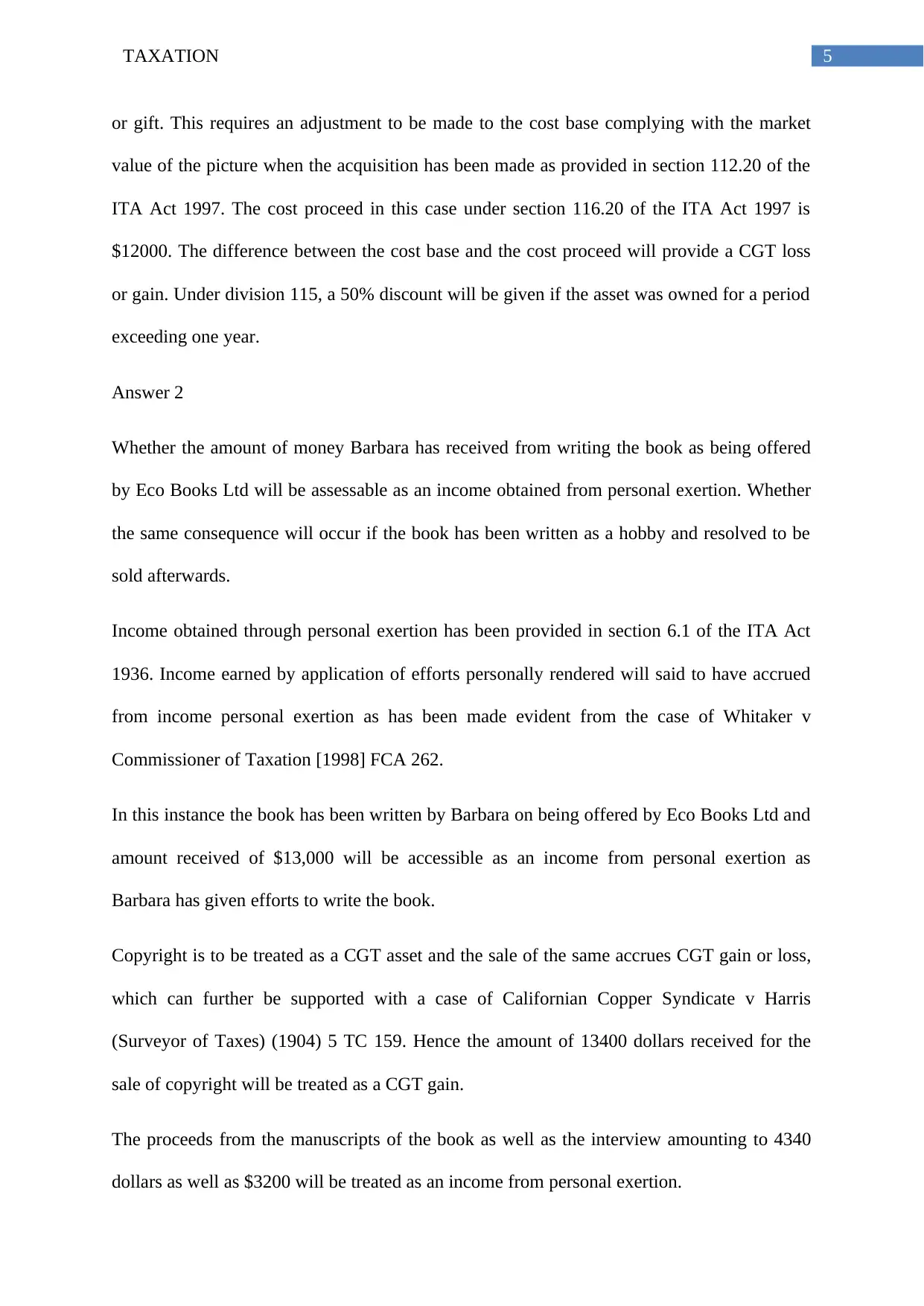
5TAXATION
or gift. This requires an adjustment to be made to the cost base complying with the market
value of the picture when the acquisition has been made as provided in section 112.20 of the
ITA Act 1997. The cost proceed in this case under section 116.20 of the ITA Act 1997 is
$12000. The difference between the cost base and the cost proceed will provide a CGT loss
or gain. Under division 115, a 50% discount will be given if the asset was owned for a period
exceeding one year.
Answer 2
Whether the amount of money Barbara has received from writing the book as being offered
by Eco Books Ltd will be assessable as an income obtained from personal exertion. Whether
the same consequence will occur if the book has been written as a hobby and resolved to be
sold afterwards.
Income obtained through personal exertion has been provided in section 6.1 of the ITA Act
1936. Income earned by application of efforts personally rendered will said to have accrued
from income personal exertion as has been made evident from the case of Whitaker v
Commissioner of Taxation [1998] FCA 262.
In this instance the book has been written by Barbara on being offered by Eco Books Ltd and
amount received of $13,000 will be accessible as an income from personal exertion as
Barbara has given efforts to write the book.
Copyright is to be treated as a CGT asset and the sale of the same accrues CGT gain or loss,
which can further be supported with a case of Californian Copper Syndicate v Harris
(Surveyor of Taxes) (1904) 5 TC 159. Hence the amount of 13400 dollars received for the
sale of copyright will be treated as a CGT gain.
The proceeds from the manuscripts of the book as well as the interview amounting to 4340
dollars as well as $3200 will be treated as an income from personal exertion.
or gift. This requires an adjustment to be made to the cost base complying with the market
value of the picture when the acquisition has been made as provided in section 112.20 of the
ITA Act 1997. The cost proceed in this case under section 116.20 of the ITA Act 1997 is
$12000. The difference between the cost base and the cost proceed will provide a CGT loss
or gain. Under division 115, a 50% discount will be given if the asset was owned for a period
exceeding one year.
Answer 2
Whether the amount of money Barbara has received from writing the book as being offered
by Eco Books Ltd will be assessable as an income obtained from personal exertion. Whether
the same consequence will occur if the book has been written as a hobby and resolved to be
sold afterwards.
Income obtained through personal exertion has been provided in section 6.1 of the ITA Act
1936. Income earned by application of efforts personally rendered will said to have accrued
from income personal exertion as has been made evident from the case of Whitaker v
Commissioner of Taxation [1998] FCA 262.
In this instance the book has been written by Barbara on being offered by Eco Books Ltd and
amount received of $13,000 will be accessible as an income from personal exertion as
Barbara has given efforts to write the book.
Copyright is to be treated as a CGT asset and the sale of the same accrues CGT gain or loss,
which can further be supported with a case of Californian Copper Syndicate v Harris
(Surveyor of Taxes) (1904) 5 TC 159. Hence the amount of 13400 dollars received for the
sale of copyright will be treated as a CGT gain.
The proceeds from the manuscripts of the book as well as the interview amounting to 4340
dollars as well as $3200 will be treated as an income from personal exertion.
⊘ This is a preview!⊘
Do you want full access?
Subscribe today to unlock all pages.

Trusted by 1+ million students worldwide
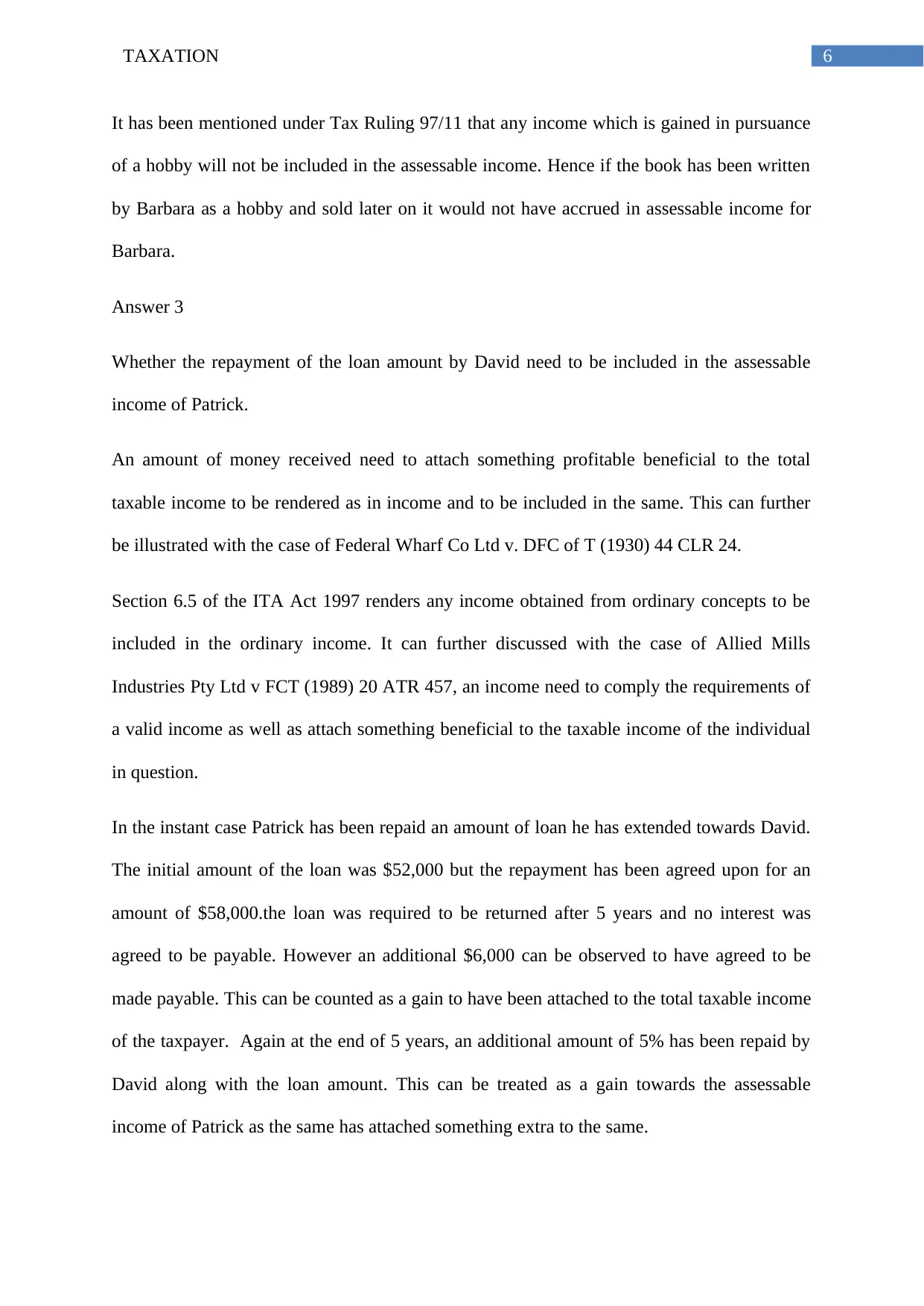
6TAXATION
It has been mentioned under Tax Ruling 97/11 that any income which is gained in pursuance
of a hobby will not be included in the assessable income. Hence if the book has been written
by Barbara as a hobby and sold later on it would not have accrued in assessable income for
Barbara.
Answer 3
Whether the repayment of the loan amount by David need to be included in the assessable
income of Patrick.
An amount of money received need to attach something profitable beneficial to the total
taxable income to be rendered as in income and to be included in the same. This can further
be illustrated with the case of Federal Wharf Co Ltd v. DFC of T (1930) 44 CLR 24.
Section 6.5 of the ITA Act 1997 renders any income obtained from ordinary concepts to be
included in the ordinary income. It can further discussed with the case of Allied Mills
Industries Pty Ltd v FCT (1989) 20 ATR 457, an income need to comply the requirements of
a valid income as well as attach something beneficial to the taxable income of the individual
in question.
In the instant case Patrick has been repaid an amount of loan he has extended towards David.
The initial amount of the loan was $52,000 but the repayment has been agreed upon for an
amount of $58,000.the loan was required to be returned after 5 years and no interest was
agreed to be payable. However an additional $6,000 can be observed to have agreed to be
made payable. This can be counted as a gain to have been attached to the total taxable income
of the taxpayer. Again at the end of 5 years, an additional amount of 5% has been repaid by
David along with the loan amount. This can be treated as a gain towards the assessable
income of Patrick as the same has attached something extra to the same.
It has been mentioned under Tax Ruling 97/11 that any income which is gained in pursuance
of a hobby will not be included in the assessable income. Hence if the book has been written
by Barbara as a hobby and sold later on it would not have accrued in assessable income for
Barbara.
Answer 3
Whether the repayment of the loan amount by David need to be included in the assessable
income of Patrick.
An amount of money received need to attach something profitable beneficial to the total
taxable income to be rendered as in income and to be included in the same. This can further
be illustrated with the case of Federal Wharf Co Ltd v. DFC of T (1930) 44 CLR 24.
Section 6.5 of the ITA Act 1997 renders any income obtained from ordinary concepts to be
included in the ordinary income. It can further discussed with the case of Allied Mills
Industries Pty Ltd v FCT (1989) 20 ATR 457, an income need to comply the requirements of
a valid income as well as attach something beneficial to the taxable income of the individual
in question.
In the instant case Patrick has been repaid an amount of loan he has extended towards David.
The initial amount of the loan was $52,000 but the repayment has been agreed upon for an
amount of $58,000.the loan was required to be returned after 5 years and no interest was
agreed to be payable. However an additional $6,000 can be observed to have agreed to be
made payable. This can be counted as a gain to have been attached to the total taxable income
of the taxpayer. Again at the end of 5 years, an additional amount of 5% has been repaid by
David along with the loan amount. This can be treated as a gain towards the assessable
income of Patrick as the same has attached something extra to the same.
Paraphrase This Document
Need a fresh take? Get an instant paraphrase of this document with our AI Paraphraser
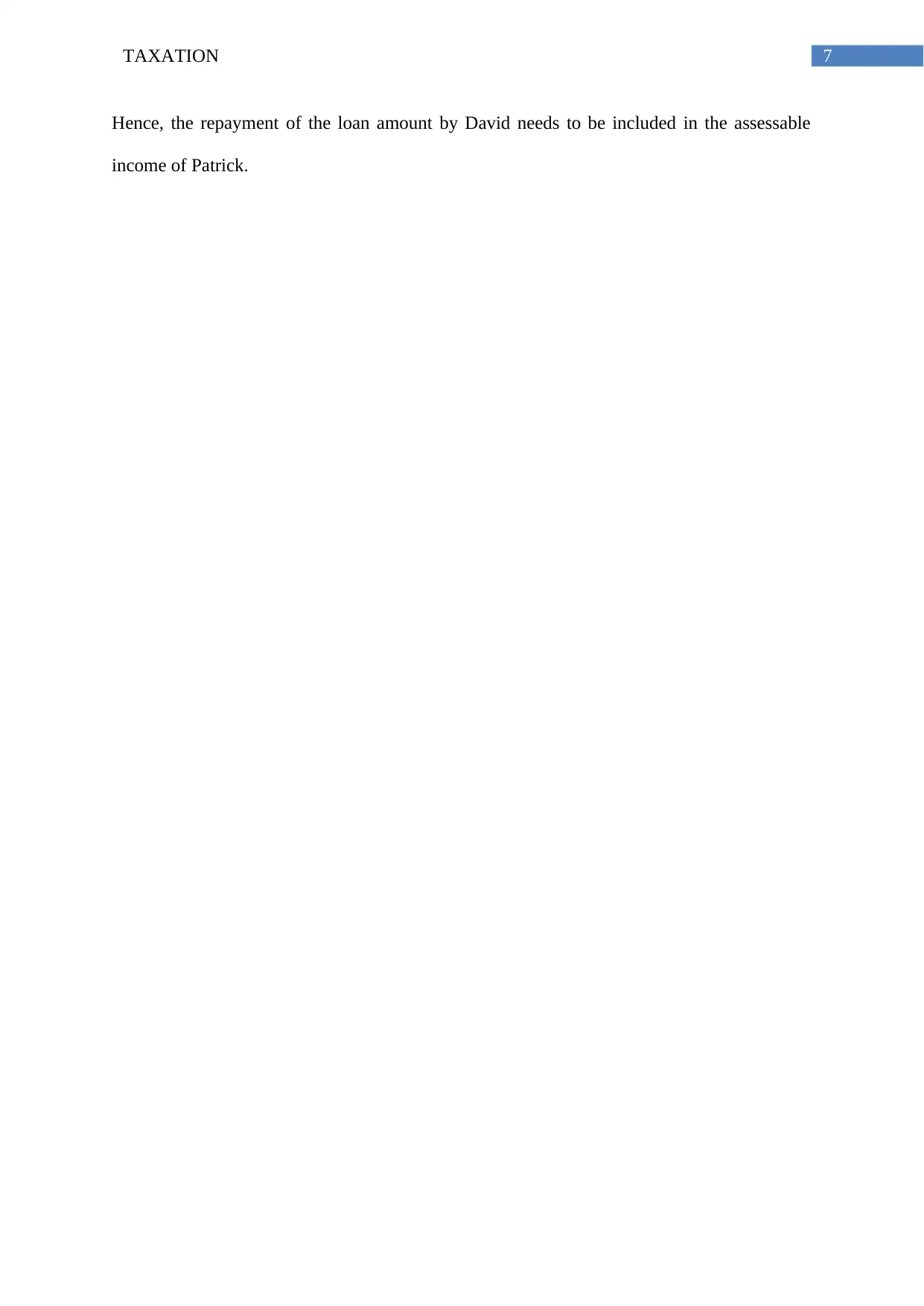
7TAXATION
Hence, the repayment of the loan amount by David needs to be included in the assessable
income of Patrick.
Hence, the repayment of the loan amount by David needs to be included in the assessable
income of Patrick.
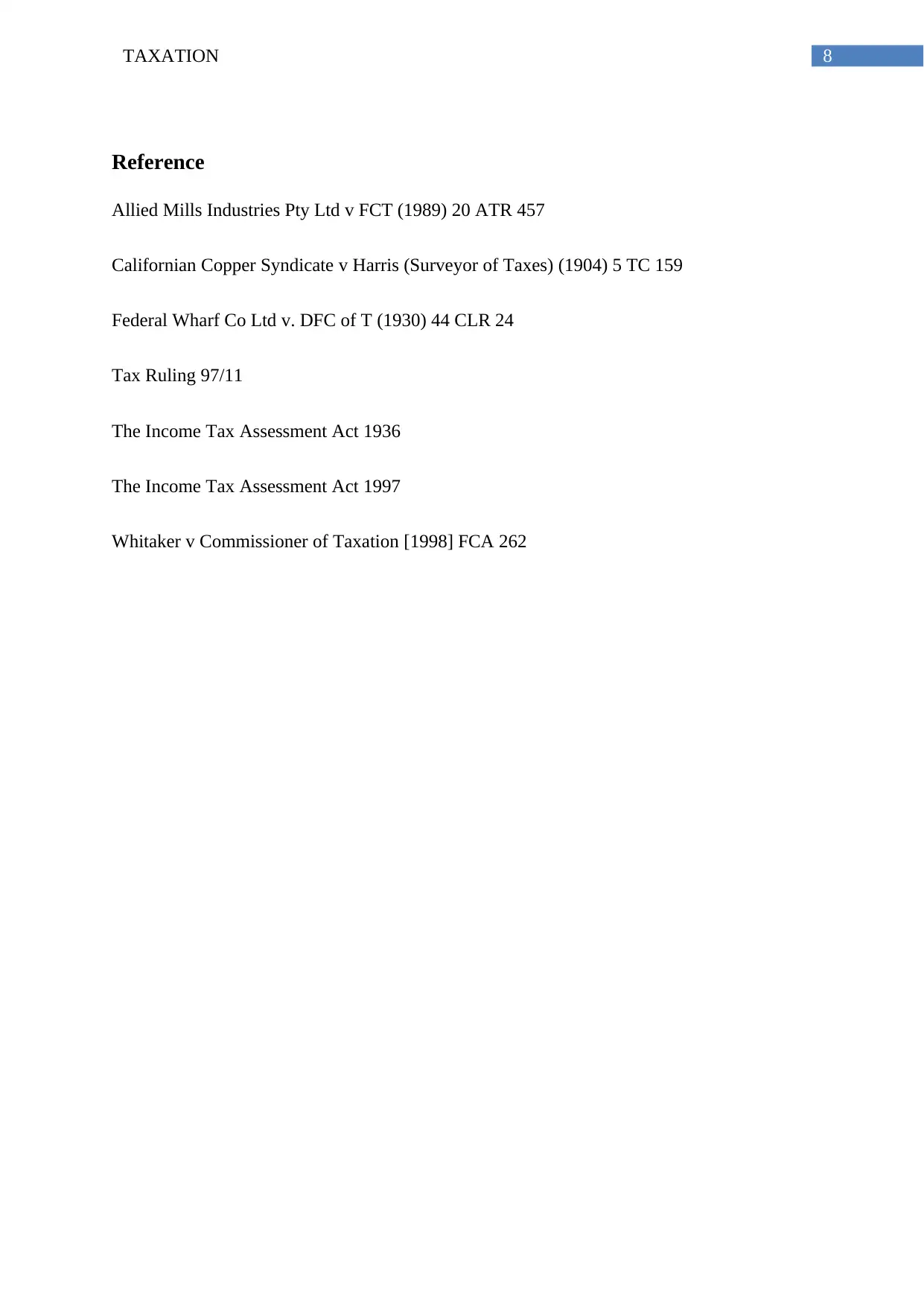
8TAXATION
Reference
Allied Mills Industries Pty Ltd v FCT (1989) 20 ATR 457
Californian Copper Syndicate v Harris (Surveyor of Taxes) (1904) 5 TC 159
Federal Wharf Co Ltd v. DFC of T (1930) 44 CLR 24
Tax Ruling 97/11
The Income Tax Assessment Act 1936
The Income Tax Assessment Act 1997
Whitaker v Commissioner of Taxation [1998] FCA 262
Reference
Allied Mills Industries Pty Ltd v FCT (1989) 20 ATR 457
Californian Copper Syndicate v Harris (Surveyor of Taxes) (1904) 5 TC 159
Federal Wharf Co Ltd v. DFC of T (1930) 44 CLR 24
Tax Ruling 97/11
The Income Tax Assessment Act 1936
The Income Tax Assessment Act 1997
Whitaker v Commissioner of Taxation [1998] FCA 262
⊘ This is a preview!⊘
Do you want full access?
Subscribe today to unlock all pages.

Trusted by 1+ million students worldwide
1 out of 9
Related Documents
Your All-in-One AI-Powered Toolkit for Academic Success.
+13062052269
info@desklib.com
Available 24*7 on WhatsApp / Email
![[object Object]](/_next/static/media/star-bottom.7253800d.svg)
Unlock your academic potential
Copyright © 2020–2025 A2Z Services. All Rights Reserved. Developed and managed by ZUCOL.





